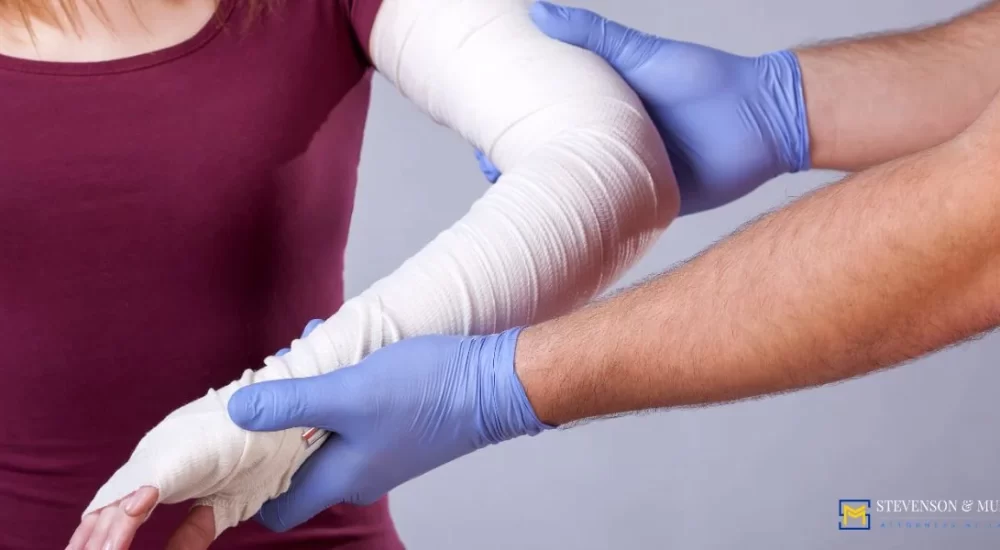|
|
Last Modified on Nov 20, 2024
The personal injury lawyers at Stevenson & Murray understand that if you or a loved one are facing a serious burn, you may be wondering, “Which type of burn injury requires skin grafting in Texas?” It is important that you get answers and know what type of medical intervention you may be facing. Burns have the potential to impact your future, which makes it important to address and understand your options under these circumstances.
Burns and Skin Grafting
In the state of Texas, like other locations, skin grafting may be necessary for severe burn injuries that involve significant skin damage and cannot heal on their own. The types of burns that may require skin grafting include the following:
- Third-Degree Burns: Third-degree burns destroy the dermis and epidermis layers of skin which leaves no skin to regenerate naturally after a burn. Skin grafts can be used to close a wound, help reduce the risk of infection, and foster a speedy recovery and healing.
- Deep Second-Degree Burns: It is possible that a partial-thickness burn may heal without grafting, but deep second-degree burns often damage the dermis extensively, which may need a graft to restore the skin’s health and integrity.
- Fourth-Degree Burns: Severe burns that impact more than just the skin and hit muscles, tendons, and bones may need skin grafting as a part of a larger reconstruction effort to restore the functionality of the area and appearance.
Texas houses several quality burn centers in city hubs like Dallas and Houston that offer advanced treatment options like skin grafting. If the burn was caused by another person or party’s negligence, like if it happened because of a defective product, victims may be able to receive compensation for the cost of grafting and recovery through a personal injury claim.
How to Get Compensation After a Severe Burn
In the event that you have suffered a serious burn due to someone else’s negligence and need a procedure such as a skin graft, you may be entitled to compensation that covers your medical expenses, lost wages, and emotional damage. It is vital that after a burn, you follow the steps needed to receive medical care and that you document that care.
Once the immediate physical needs are handled after a burn, it is important to identify if there is a responsible party. Responsible parties could be an employer if the burn happened due to unsafe working conditions, a driver in the case of a car accident, a manufacturer if a defective product caused the burn, or a property owner if the burn is a result of an unsafe premises. If you can identify this party, you may have the means to pursue a legal claim.
Pursuing a Legal Claim
To pursue a claim, it is helpful to partner with a burn injury lawyer who has experience working with injury cases to help identify what type of legal action is the right option for your unique case, and once this is identified, file a claim. For most non-workplace accidents, a personal injury claim may be ideal to receive compensation for damages.
To receive accurate compensation, a detailed damage calculation is necessary. Compensation can cover economic losses like medical expenses and lost wages. Non-economic damages can cover intangible losses like pain and suffering, and emotional distress.
It is important that you not delay action as there are often deadlines associated with taking legal action for cases like a burn injury. Burns can not only impact your physical body and health but also your financial and emotional future, depending on the details of the accident, so pursuing a claim may be in your ideal interest.
FAQs
What Should I Do If I Have a Serious Burn After an Accident?
If you get a serious burn caused by an accident, you should seek immediate first aid and stop the burning process by addressing the source of the burn, such as extinguishing flames or removing yourself from the burning area. It is vital to get emergency medical support as soon as possible to ensure the burn is properly addressed to prevent serious infections and scarring. If the accident occurred due to fault from another party, keep documentation to prove liability.
What Is a Skin Graft?
A skin graft is a medical procedure where healthy skin is taken from one part of an individual’s body and transplanted to another area of the body where the skin has been damaged or lost, often because of burns, injuries, or infections. There are different levels and types of skin grafts that can take different amounts and depths of skin depending on the level of coverage needed.
How Do You Get a Skin Graft?
You get a skin graft by having a surgical procedure where a wound area is cleaned and covered with another part of healthy skin, often referred to as the donor site. This procedure may require general anesthesia to help with pain management during the procedure. The skin is harvested and placed over the wound and secured with sutures, staples, or adhesives.
What Are the Different Types of Burns?
The different types of burns are often categorized based on their depth, severity, and the layers of skin and tissue the burn impacts. First-degree burns are the least severe as they only impact the outer layer of the skin, and they have mild symptoms like redness and mild swelling; these burns can happen from a sunburn. Fourth-degree burns are the most severe types of burns as they go beyond just the skin to muscles, tendons, and bones.
Get in Touch With a Trusted Personal Injury Lawyer as Soon as Possible
If you are facing a serious burn that happened because of another party’s action or inaction, you may have the grounds to pursue a personal injury claim, which can help you recover compensation for the losses you have suffered related to the incident. Reach out to Stevenson & Murray to set up an initial consultation with our trusted legal team. We can help you understand your legal options and fight for compensation that accurately covers your loss.






